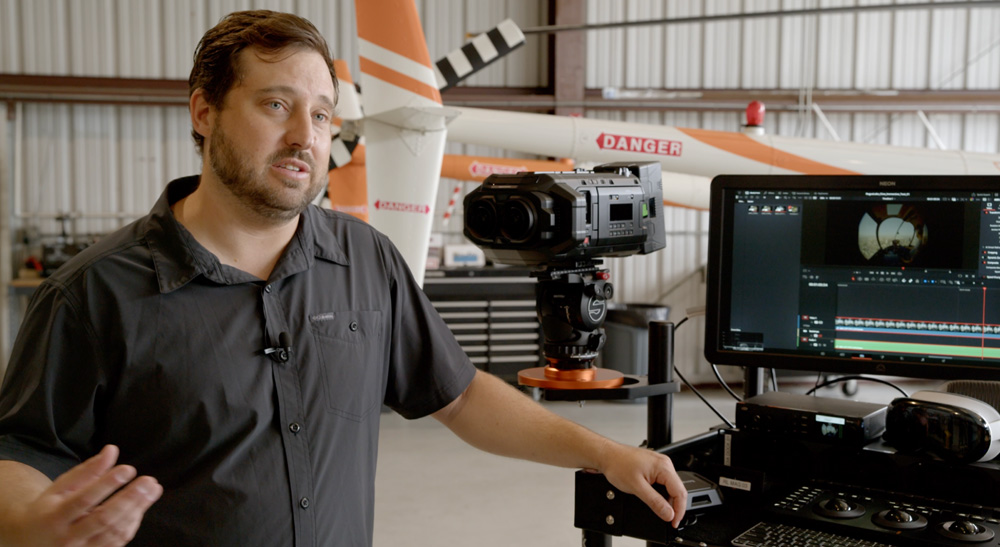Large format sensor creates a uniquely intimate shooting style.
Fremont, CA, USA – Tuesday, September 30, 2025 – Blackmagic Design today announced that cinematographer Blake McClure, ASC recently completed principal photography using the Blackmagic URSA Cine 17K 65 digital film camera.
McClure, best known for his work on high profile episodics such as “The Dropout,” “Miracle Workers” and “Loot,” chose the URSA Cine 17K 65 to shoot his most recent project. His introduction to the new large format camera came through seeing work shot by cinematographer Dylan Rucker. “I saw this demo that Dylan shot,” said McClure. “One frame stuck with me: a man sipping coffee in a kitchen, looking out over a ranch. That single image hooked me. It instantly reminded me of medium format portrait photography. I could feel the camera’s proximity to the actor, the way the background fell off so gracefully, and how naturally the skin tones rendered. The tones were perfect. A simple frame, yet incredibly effective.”
McClure, who is accustomed to shooting episodic shows with a very static visual style, wanted something different for his new project. “In half hour shows, there’s rarely room for dynamic camera movement,” he continued. “I’ve always had to rely on lighting and color to bring visual interest. Coverage is usually limited to over the shoulder shots, clean singles, and the occasional wide. I was looking for something new.”
The 65mm sensor on the URSA Cine 17K 65 gave McClure an opportunity to shoot with a different perspective.
“A large sensor lets you get closer to the subject on a normal lens without distortion. We were shooting medium shots on a 55mm from about seven feet away. To get the same field of view on Super 35, we’d need a 30mm lens or be double the distance from the subject. I wanted the show to feel like a portrait, intimate and relationship driven. I’ve always loved medium format photography, and this was the closest I’ve been to that in motion,” he said.
For first assistant camera Logan Hall, the camera’s functionality was important. “My only real experience with past Blackmagic cameras was the Pocket Cinema Camera 6K Pro, which was a completely different form factor than what I was used to,” said Hall. “The URSA Cine 17K 65’s body is more familiar and allowed us as ACs to translate a more native workflow to this camera body.”
Using a cage system, Hall could configure the camera in any way he needed. “We could build the camera in almost any configuration that we could hope for, whether it be for studio work, on a Steadicam, or even on compact gimbals like the Ronin 2,” he noted.
An added bonus was the URSA Cine 17K 65’s second monitor built into the right side of the camera, a feature not seen in most other systems. “Having the two built in monitors was incredibly helpful,” added Hall. “There were many times where Blake was on set making adjustments, and no matter what side of the camera he was on, he was able to just glance at the monitor without having to go all the way back to DIT. I found the directors, assistant directors and even production assistants looking at the AC side monitor, which allowed them to see all the adjustments they were making on the fly, all while being able to stay close to the action.”
The advantages of the URSA Cine 17K 65’s unique RGBW sensor and its ability to offer multiple compression options allowed McClure to manage his data use actively. “We shot at open gate 8K, and the ability to shoot multiple high resolution formats without any image crop is an amazing advantage on this camera,” added McClure. “On the camera, you can also record at a constant compression setting, which is standard practice, or use the Constant Quality mode. We shot in Q3, which allocates more data to areas of high detail and less to static parts of the frame, reducing the overall data rate. You don’t notice it visually, but it means smaller file sizes. This made it an easier sell to the studio, since we weren’t asking them to approve a massive data storage footprint for the DIT or post production.”
Ultimately, it was the ability to tell a unique story with the URSA Cine 17K 65’s large format sensor that attracted McClure and made the most impact on production. “Every time a new actor came to set, they’d comment on how close the cameras were to them during a scene,” said McClure. “They assumed we were using super wide lenses for close ups, but once we showed them the frame, they couldn’t believe the look we were getting. The images blew everyone away.”

About Blackmagic Design
Blackmagic Design creates the world’s highest quality video editing products, digital film cameras, color correctors, video converters, video monitoring, routers, live production switchers, disk recorders, waveform monitors and real time film scanners for the feature film, post production and television broadcast industries. Blackmagic Design’s DeckLink capture cards launched a revolution in quality and affordability in post production, while the company’s Emmy™ award winning DaVinci color correction products have dominated the television and film industry since 1984. Blackmagic Design continues ground breaking innovations including 6G-SDI and 12G-SDI products and stereoscopic 3D and Ultra HD workflows. Founded by world leading post production editors and engineers, Blackmagic Design has offices in the USA, UK, Japan, Singapore and Australia. For more information, please go to www.blackmagicdesign.com.

